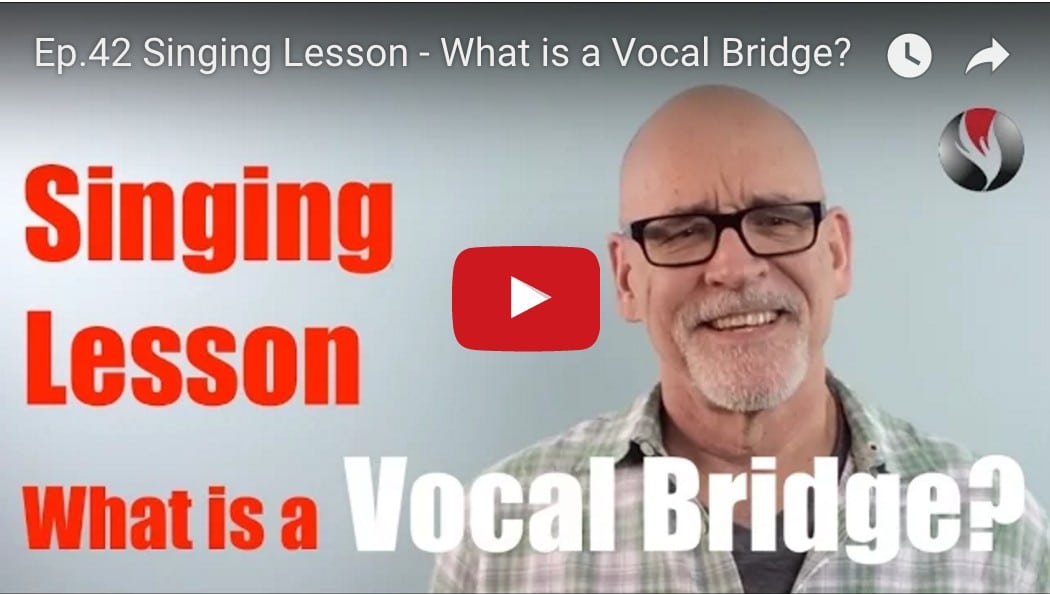Ep.42 Singing Lesson – What is a Vocal Bridge?
This is a singing lesson about the vocal bridge. What is a Vocal Bridge?
Physically, what is it? What is happening? Why does it feel so impossible?
Inside this video singing lesson, we’ll discuss what a vocal bridge actually is and how it can make or break your singing.
Isn’t it amazing that everyone has a vocal bridge, but very few even know or care about it?
If you’re a singer, you learn about it because it can be one of the biggest obstacles you ever face.
As a young singer, I sang up to about the E above middle C and had to stop. If I sang any higher I’d have to yell or break into falsetto. So I thought that was the top of my range. That’s all the higher I could sing (or should sing).
My best friend sang a lot higher than that. He was a tenor.
So I just thought I was born to sing only to the E above middle C. In high school I had a voice teacher who had her Master’s Degree in Vocal Performance. That’s what she thought too.
But it’s not a limitation of birth. It’s not that I’m a bass. It’s something called the Vocal Bridge. In the singing community it’s called the passaggio or the break. Sometimes it’s called the Middle.
For many of us singers it’s like a huge barricade or gigantic obstacle. You can’t get through it. You can’t get around it. You just smash into it.
Singing Lesson What is a Vocal Bridge?
The vocal bridge is a passageway. It’s where the vibration created by the vocal cords wants to leave your chest and move into your head. This happens when you start on low notes and sing higher and higher. Eventually the vibrations of the higher pitches seek the smaller cavities of the head.
The vibrations (or resonance) physically begin to move upward into your head. If you don’t know it’s suppose to be happening you stop singing because you feel like you can’t go and higher. Or you push harder, or you tense up, or you squeeze the sound out. Or you sing louder, or you crack or break into falsetto. Or you might go extremely light and soft.
As the resonance shifts into the head, the vocal cords must make an adjustment. They gradually eliminate the mass of the vibrating portion of the vocal cords. This means they thin. They also stretch and increase in internal tension. There’s a portion of the cords that handoff their function to another portion of the vocal cords.
If these things don’t happen, you don’t get through the bridge successfully.
Singing Lesson – Why is it so hard to get through the bridge?
- It’s hard because we don’t even know we should…guys especially. Girls have too, because most of their voice is above the first bridge.
- It’s hard because we don’t think it’s possible…in fact…we think it’s impossible for us.
- It’s hard because even if we learn about it, even if we see someone else do it, our minds are telling us we can’t.
- It’s hard because it’s feels wrong or awkward. It doesn’t feel like the right thing to feel when you’re singing.
- It’s hard because it feels unfamiliar. Like nothing we’ve ever felt before.
- It’s hard because it takes some effort to get good at it.
- It’s hard because to get really good at it may take desire and work.
Singing Lesson – Does Everyone Have a Bridge?
Everyone has multiple bridges. But it’s the first bridge that’s the most challenging. Some singers are able to sing through their first bridge easily. For them, they hardly notice the bridge. This seems to be a gift they’re born with. To see where your bridges are located, watch Ep.#39 on Mastering the Middle.
Singing Lesson – How do you Sing In the First Bridge?
We all want to sing through the bridge to the higher notes. But how do we sing the notes that are directly in the First Bridge?
We must learn to live with a new feeling. This new feeling is caused by the split resonance. As you sing into the bridge, you experience both chest and head resonance happening at the same time.
You must be able to allow both of these vibrations to blend or mix together. You’ve got head and chest going at the same time.
This new feeling is also caused by the vocal cords adjusting as you sing higher.
The combination of the split resonance of head and chest voice and the vocal cord adjustments feels strange to us at first. It takes time and practice to get used to this new coordination.
When you do this successfully, you are singing in a Mix. You are singing with a mix of chest and head resonance.
Mix is a vocal type. Do you know what you tend to do when you sing into the First Bridge?
To discover your vocal type, go to PowerToSing.com and take the vocal test, which I call the PowerTest.
Take the quiz and immediately discover your vocal type.
Visit the Knowledge Center and watch the videos about your vocal type and download the exercises designed for your voice. These exercises are designed to help you sing in and through the first bridge.
I’m Chuck Gilmore with Power to Sing.
You can sing higher with beauty, confidence and power.
I’ll see you inside the next video.















Responses